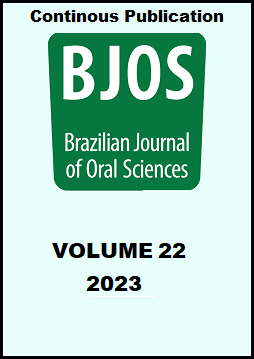Abstract
Aim: This study aimed to evaluate if there is a dose-response relationship between toothpaste chemically soluble fluoride absorbed in the gastrointestinal tract and fluoride secreted by saliva, giving support to the use of saliva as surrogate for plasma fluoride. Methods: A 4-phase single blind study was conducted, in which 10 participants were subjected in each phase to one of the assigned treatment groups: group I: fresh sample of a Na2FPO3/CaCO3-based toothpaste with 1,334 μg F/g of total soluble fluoride (TSF) and groups II–IV: aged samples of this toothpaste presenting TSF concentrations of 1,128, 808, and 687 μg F/g, respectively. In all phases, the participants ingested an amount of toothpaste equivalent to 70.0 μg F/Kg body weight, as total fluoride (TF). Saliva and blood samples were collected before (baseline) and up to 180 min after toothpaste ingestion as indicator of fluoride bioavailability. F concentration in saliva and blood plasma was determined with a fluoride ion-specific electrode. The areas under the curve (AUC) of F concentration versus time (AUC = ng F/mL × min) and the peaks of fluoride concentration (Cmax) in saliva and plasma were calculated. Results: A significant correlation between mg of TSF ingested and the AUC (r=0.47; p<0.01), and Cmax (r=0.59; p<0.01) in saliva was found; for TF, the correlation was not significant (p>0.05). In addition, the correlations between plasma and saliva fluoride concentrations were statistically significant for AUC (r=0.55; p<0.01) as for Cmax (r=0.68; p<0.01). Conclusion: The findings support that saliva can be used as a systemic biomarker of bioavailable fluoride present in Na2FPO3/ CaCO3-based toothpaste.
References
Wong MC, Clarkson J, Glenny AM, Lo EC, Marinho VC, Tsang BW, et al. Cochrane reviews on the benefits/risks of fluoride toothpastes. J Dent Res. 2011 May;90(5):573-9. doi: 10.1177/0022034510393346.
Oliveira MJ, Martins CC, Paiva SM, Tenuta LM, Cury JA. Estimated fluoride doses from toothpastes should be based on total soluble fluoride. Int J Environ Res Public Health. 2013 Nov;10(11):5726-36. doi: 10.3390/ijerph10115726.
Caldas da Rocha DR, Ricomini Filho AP, Cury JA. Soluble fluoride in na2fpo3/caco3-based toothpaste as an indicator of systemically bioavailable fluoride. Caries Res. 2022;56(1):55-63. doi: 10.1159/000521068.
Fejerskov O, Manji F, Baelum V. The nature and mechanisms of dental fluorosis in man. J Dent Res. 1990 Feb;69 Spec No:692-700; discussion 721. doi: 10.1177/00220345900690S135.
Fejerskov O, Cury JA, Tenuta LMA, Marinho VM. Fluorides in caries control. In: Fejerskov O, Nyvad B, Kidd E, editors. Dental caries: the disease and its clinical management. 3rd ed. Oxford: Wiley-Blackwell; 2015. p.245-72.
Ekstrand J, Spak CJ, Vogel G. Pharmacokinetics of fluoride in man and its clinical relevance. J Dent Res. 1990 Feb;69 Spec No:550-5; discussion 556-7. doi: 10.1177/00220345900690S109.
Ekstrand J, Alván G, Boréus LO, Norlin A. Pharmacokinetics of fluoride in man after single and multiple oral doses. Eur J Clin Pharmacol. 1977 Dec;12(4):311-7. doi: 10.1007/BF00607432.
Oliveby A, Lagerlöf F, Ekstrand J, Dawes C. Studies on fluoride excretion in human whole saliva and its relation to flow rate and plasma fluoride levels. Caries Res. 1989;23(4):243-6. doi: 10.1159/000261185.
Cury JA, Del Fiol FS, Tenuta LM, Rosalen PL. Low-fluoride dentifrice and gastrointestinal fluoride absorption after meals. J Dent Res. 2005 Dec;84(12):1133-7. doi: 10.1177/154405910508401208.
Falcão A, Tenuta LM, Cury JA. Fluoride gastrointestinal absorption from Na2FPO3/CaCO3- and NaF/SiO2-based toothpastes. Caries Res. 2013;47(3):226-33. doi: 10.1159/000346006.
Roldi CR, Cury JA. [Fluoride metabolism after ingestion of dentifrice]. RGO.1986; 34: 425–7. Portuguese.
Drummond BK, Curzon ME, Strong M. Estimation of fluoride absorption from swallowed fluoride toothpastes. Caries Res. 1990;24(3):211-5. doi: 10.1159/000261267.
Spak CJ, Ekstrand J, Zylberstein D. Bioavailability of fluoride added by baby formula and milk. Caries Res. 1982;16(3):249-56. doi: 10.1159/000260605.
Burt BA. The changing patterns of systemic fluoride intake. J Dent Res. 1992 May;71(5):1228-37. doi: 10.1177/00220345920710051601.
Fernández CE, Tenuta LMA, Cury JA. [Wash-out period for crossover design experiments using high fluoride concentration dentifrice]. Rev Clin Periodoncia Implantol Rehabil Oral. 2015 Apr;8(1):1-6. Spanish. doi: 10.1016/j.piro.2014.12.002.
Cury JA, Oliveira MJ, Martins CC, Tenuta LM, Paiva SM. Available fluoride in toothpastes used by Brazilian children. Braz Dent J. 2010;21(5):396-400. doi: 10.1590/s0103-64402010000500003.
Dawes C, Wong DTW. Role of Saliva and Salivary Diagnostics in the Advancement of Oral Health. J Dent Res. 2019 Feb;98(2):133-41. doi: 10.1177/0022034518816961.

This work is licensed under a Creative Commons Attribution 4.0 International License.
Copyright (c) 2022 Deborah Rackel Caldas da Rocha, Antônio Pedro Ricomini Filho, Cinthia Pereira Machado Tabchoury, Jaime Cury


